Assessment of Seasonal Variation in Physicochemical Characteristics of the Soil at Gautala Reserve Forest (M.S), India
Corresponding author Email: amrin.42@rediffmail.com
DOI: http://dx.doi.org/10.12944/CWE.15.2.17
The aim of study was to investigate the seasonal changes of physicochemical parameters in the soil of selected 15 spots of the Gautala reserve forest. The soil is consist of the most significant natural factors, which is created by weathering of the rocks existing in the environment. The present survey was made to study consists the physicochemical parameters in the soil of the Gautala Reserve Forest during the year 2017-18 at three seasonal intervals i.e. rainy, winter and summer seasons. The soil parameters examined were soil pH, soil texture, moisture content, bulk density, electrical conductivity (EC),organic carbon (OC), available Nitrogen (N), available Phosphorus (P), and available Potassium (K). The Gautala forest soil physical property was analyzed as sandy loam and silty loam. The pH and Organic carbon levels were low during summer and high in monsoon. The total amount of available N, P, K, electrical conductivity, water holding capacity and moisture content were maximum in monsoon and minimum in summer season. The physicochemical properties are dependent variables that play an important role in order to understand plant diversity.
Copy the following to cite this article:
Mirza A. N, Patil S. S. Assessment of Seasonal Variation in Physicochemical Characteristics of the Soil at Gautala Reserve Forest (M.S), India. Curr World Environ 2020; 15(2). DOI:http://dx.doi.org/10.12944/CWE.15.2.17
Copy the following to cite this URL:
Mirza A. N, Patil S. S. Assessment of Seasonal Variation in Physicochemical Characteristics of the Soil at Gautala Reserve Forest (M.S), India. Curr World Environ 2020; 15(2). Available from: https://bit.ly/2AP2ptX
Download article (pdf)
Citation Manager
Publish History
Select type of program for download
| Endnote EndNote format (Mac & Win) | |
| Reference Manager Ris format (Win only) | |
| Procite Ris format (Win only) | |
| Medlars Format | |
| RefWorks Format RefWorks format (Mac & Win) | |
| BibTex Format BibTex format (Mac & Win) |
Article Publishing History
| Received: | 20-03-2020 |
|---|---|
| Accepted: | 08-06-2020 |
| Reviewed by: | 
 Rishikesh Singh
Rishikesh Singh
|
| Second Review by: |

 Ali Noor Shah
Ali Noor Shah
|
| Final Approval by: | Dr Gopal Krishan |
Introduction
Soil is a crucial element of several terrestrial ecosystems by itself, it hosts enormous biodiversity, both in terms of species abundance and functionality. The soil is a biological medium for plant growth (Ghorade, 2013). It is crucial fact that water covers approximately 71% of total surface of Earth and about 3% of water is fresh. Out of these approximately 3% of water, 2.5% water is available in Antarctica in the solid form i.e. ice (Bhadra et al., 2014). Water plays an imperative role in the development of different sectors of the economy, including agriculture, cattle production, forestry, industrial electricity generation, fisheries, and other innovative activities (Bouslah et al. 2017). Besides, artificial activities such as open Defecations in the beds of river, release of biomedical wastes etc. enhance the amount of harmful pathogenic bacteria and protozoans in the river flows (Pardeshi and Baidya, 2015).
Forest soil plays a crucial role in determining the sustainable efficiency of forest ecologies. Soil fertility is generally connected with soil superiority and soil conditions (Ajgaonkar, 2017). Forest lands with good physical and chemical characteristics are essential for maintaining efficiency in earthly ecosystems and driving processes that preserve environmental superiority(Dar, 2018).There are various components that determine soil nature i.e. pH, nutrient level an organic content. These elements can vary depending on the type of plant which grows in the soil and also on geographical location (Lamture 2015). Soil properties of terrestrial ecosystems rely on an assortment of abiotic and biotic components that fluctuate both spatially and seasonally (Peverill, 1999; Dar, 2018). Among abiotic factors complete Ion content, corrosiveness, carbon, nitrogen and absolute Phosphorus fluctuate on the spatial scale in the topsoil. Some additional factors like atmosphere, landform, geology, soil texture, soil moisture, and floral community structure also affect soil composition (Maria,2004; Takata, 2008).The temperature of the Gautala forest is between 27.5-30.5 0C and during the rainy season, the normal precipitation is about 600 mm (Gitte et al.,2012). The physicochemical properties are dependent variables that play an important role in order to understand plant diversity. The present study focuses on physicochemical parameters of soil i.e. soil texture, soil moisture content, water holding capacity, pH, EC (Electrical conductivity), soil organic carbon, available nitrogen, available potassium and available Phosphorus.
Material and Methods
Study Area
Gautala Reserve Forest is eminent as “Gautala Autramghat wildlife sanctuary” and it’s a dry deciduous forest. It is situated in the west-north path of the Aurangabad District, Marathwada area. It has an expanse of around 261 sq.km. It covered 197 sq.km. the territory of Aurangabad district and 64 sq. km territory of Jalgaon district. Its location at longitude E 740, 55’0, latitude N 190, 54’ and altitude 1904 ft. (Naik,1998; Kshirsagar, 2012).
 |
Figure 1: Showing the study area. Click here to View Figure |
 |
Figure 2: Showing fifteen spots selected from Gautala Reserve Forest. Click here to View Figure |
The soil samples were collected from 15 different spots of the Gautala reserve forest in three different seasons i.e. rainy, winter and summer during the year 2017-2018. The samples were taken within 0–30 cm layer after removing the litter as most of the microbial biomass is present in the surface layer. The soil samples were taken aseptically using a sterile spatula & collected in a properly labeled sterile zip-lock pouch. The soil samples were air-dried and homogenized manually. Further, the soils were sieved using a 2 mm mesh to perform physicochemical analysis. Analysis of soil was carried out to determine the physicochemical analyses in the laboratory according to the standard techniques. Total organic carbon was estimated with using the Walkley and Black (1934) method., Available nitrogen was assessed using the specified method given by Stanford and smith (1978), Kjeldahl nitrogen (Jackson, 1958). Available Phosphorus was estimated by the Olsen et al., 1983. Soil pH was measured using pH meter (Eco pH), EC was measured using a conductivity meter (Model no. LMCM20). Soil texture was determined by the hydrometric method and Soil colour was done by using Munsell’s chart. Among other parameters water holding capacity (WHC) and moisture content were analyzed by the method described by (Black et al., 1965 and Chandra et al., 2016). All the determination was replicated thrice and the mean values were used to obtain the depiction of samples.
Statistical Analysis
To analyze the results of all parameters,the correlation test is conducted between each pair of the parameter. The correlation test carried out separately for all three seasons to analyze the season wise correlation between all parameters. There are many methods to obtain the seasonal Index. Presently selected method for Seasonal Index (SI) computation is “method of simple average”. To analyze the seasonal variations in soil parameters seasonal indices were determined for each season. Seasonal index (SI) for rainy, winter and summer shows the average percentile variation in a particular season. Analyses were performed using statistical and qualitative data analysis software i.e. R Studio.
Method of Simple Averages
This is the simplest method of measuring seasonal variations in a time series. The computation of seasonal indices is made as follows,seasonal indices for different periods are obtained by expressing each period average as a percentage of the overall average x i.e. seasonal indices for different periods are;

Seasonal index for ith season,

Therefore,

Thus seasonal indices are,

Method of Correlation
The Karl Pearson correlation method is used to measure the strength of the relationship between the two numeric and continuous variables. Since the results of the parameters are continuous and normally distributed. Therefore, the Pearson correlation test is used for the analysis of soil parameters.
Result and Discussion
The data of the one year study (from June-2017 to May-2018) were pooled for three seasons and analyzed for seasonal variations, concerning rainy, winter, and summer. The results were showed a significant difference in physicochemical properties in different seasons. The ecological parameters were indicated variation in various seasons in the investigation area depending upon the geography. Physicochemical characteristics of seasonal variations in forest soil of study spots are given in (Fig 2). The Forestsoil was slightly alkaline and contained high amounts of pH, available Phosphorus, available nitrogen, and available potassium in all the three seasons examined (Table 2, 3 and 4). Most of the parameters tested were slightly higher in summer than the monsoon seasons. The samples collected from study areas were indicated that the soil was Brown to Grey and the texture was sandy loam and silt loam present in the soil of the Gautala reserve forest (Table 1).The textural contrasts of soil between land use zones could be because of leaching and deposition of sand, silt and clay during rains given the altitudinal variety and undulating forest floor at different localities of the sanctuary (Saeed, 2014). Ganguli et al.,(2016) observed the soil texture sandy loam, collected from the two different dry deciduous forests i.e. Ballavpur wildlife sanctuary, and Garhjungle west Bengal, India. The soil texture was seen to be sandy loam, it’s similar to the present results. The information demonstrated that the soil pH extended from 6.90 to7.54. The result similar to a few spots of soil surface because of the stream and lake close to certain destinations. In the present study, the pH range was maximum 8.74 in the rainy season at site 12 and a minimum of 6.63 at site 15 in the winter season. The pH conceivably might be because of rise/fall in temperature, results in increment/decline in CO2 fixation, microbial action and natural issue aggregation/decay in soils (Sivansan et al., 1993). Ali, (2017) reported the dry deciduous areas of soil colours were found Grey and Brown, these are similar to present results and additionally the outcomes, in general, indicated the soil texture had minor varieties in various land use zones of the forest.
Islam and Weil (2000) before revealed the effects of land use change on soil nature of characteristic Sal forests in Bangladesh. It is observed that soil content and silt substances, nitrogen and organic carbon were diminished with the transformation of the common forests to meadow and farming fields. Geer and Guide, (2001) stated textural characteristics of soil in Narayan Sarovar Wildlife Sanctuary in Gujarat. Horkar and Totey (2002), described a depth-wise difference in soil properties in Navegaon National Park, Maharashtra. In the present investigation, water holding capacity was high during the rainy season at site four and low in summer season at site fourteen and the moisture content maximum in the rainy season and minimum moisture content in the summer season. Due to the precipitation received at that point. In this way, it indicated a fixed regular pattern, i.e., most extreme during precipitation and least during summer months demonstrating an immediate association with precipitation (Jina et al., 2011). Hence, the water holding capacity of the soil is remarkably high (Gitte et al., 2012).
It is attributed to the rich litter deposition, less grazing impacts and due to the low mineralization caused by relatively lower temperatures under the shade of dense trees and therefore due to the slow rate of decomposition of organic matter (Moore, 1981; Mary et al., 2006). The present results of Electrical conductivity value ranged from0.10 to 0.44 (ms). An increase in organic materials leads to an increase in the electrical conductivity of the soil (Shirinfekr et al., 2007). The values of Electrical Conductivity reported by Chaudhari, (2013) were similar to the results i.e. the range in between 0.08 ms to 1.15 ms and this value recommend normal soil. The chemical properties of the soils varied significantly among samples mostly at the nutrient level. The maximum percentage of organic carbon (2.18 %) was found at site four in the rainy season and the minimum percentage of organic carbon (0.32%) was found at site six in the winter season. The organic carbon content of all sites with an average value given in table 4. The present available nitrogen range is 250.88 at site 4 in the winter season which could be because of a higher amount of available organic material (Shourkaie et al., 2007). While the lowest value recorded at site 1 is 28.36. According to the investigation, the soil nutrients are generally accessible in the spring and late-spring when summer temperature and moisture are good, and mineralization is quick (Grogan et al., 2003; Ahmadet al., 2011). Pena-claros et al.,(2012) reported organic carbon and Nitrogen strongly related to vegetation structure. The available Phosphorus value is 1.45 to 45.16 (kg/ha) and available Potassium value is 54.12 to 238.18 (kg/ha).The low amount value of available Phosphorus occur in the rainy season, because of leaching rain and soil erosion (Mohd, 2015).
Semwal et al., (2009) were stated in their investigation that the available Phosphorus was found maximum in the winter season and that the explanation was the more accumulation of minerals happens in the winter season. It is due to the presence of dense vegetation affords the soil adequate cover, thereby reducing the loss in soil micro and macronutrients that are essential for plant growth and energy fluxes as there is less vegetation cover in the grassland (Iwara et al., 2011). In the undisturbed sites the vegetation spread is more and less infiltration of sunlight and in this manner brings about less loss of humidity through evaporation (Faruqi et al., 2013).Nitrogen, Phosphorus and potassium are indicated to as the essential macronutrients of soil and generally critical to give the essentialness and execution of plant grown (Pandey, 2018).The results of the present study on the percentage of soil content in the sanctuary correlate with the earlier reports.
Statistical Relationship
Water holding capacity of soil in the summer season is 7% less than the seasonal average whereas, in rainy season 5% higher than the seasonal average, the moisture content in summer is 6 % less than the seasonal average and 4 % higher in rainy, The pH value is nearly the same for all the seasons. Hence, there is no seasonal variation. Average Electrical Conductivity is 8% less in the summer season than the seasonal average. There is no significant variation in the average Organic Carbon (%) of summer and Rainy season while in the winter season which is 3 % less than the seasonal average. Nearly 16 % average variation in the available Nitrogen of rainy and summer season. The average available Phosphorus in the winter season is 5 % less than the seasonal average. Available Potassium is 8 % high than the seasonal average in the rainy season and 6 % less than the seasonal average in the summer season (Table 5). Patil et al., (2012) reported organic carbon content i.e. 1.7 % originated in the soil of Jambughoda Wildlife Sanctuary, India.
 |
Figure 3: Showing correlation analysis of soil parameters for rainy season. Click here to View Figure |
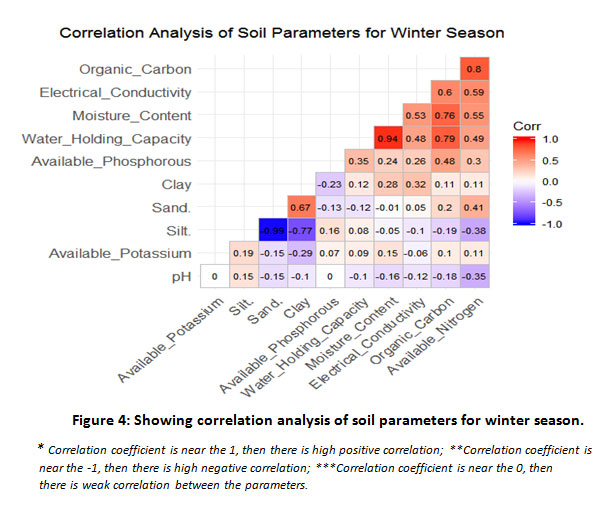 |
Figure 4: Showing correlation analysis of soil parameters for winter season. Click here to View Figure |
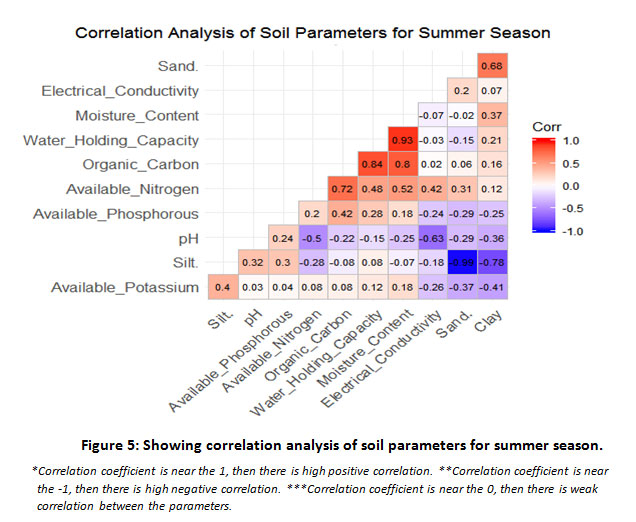 |
Figure 5: Showing correlation analysis of soil parameters for summer season. Click here to View Figure |
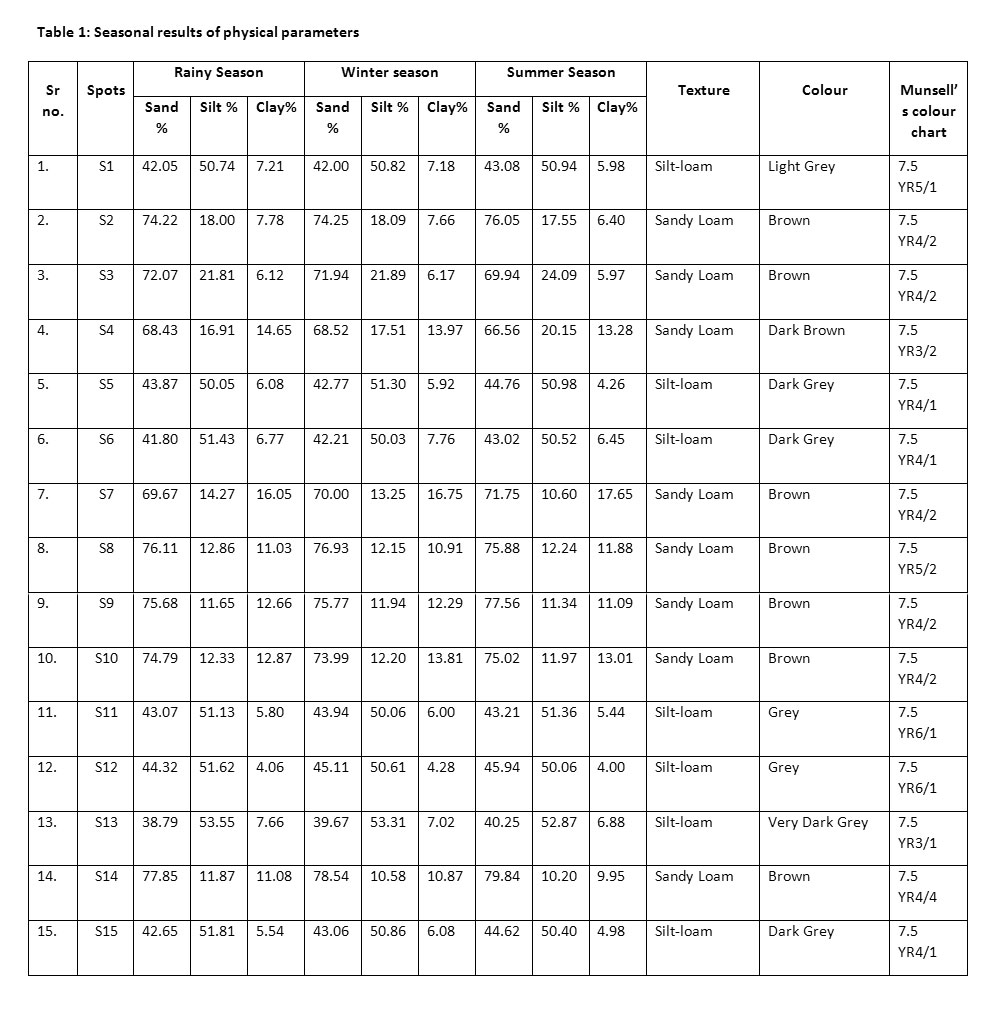 |
Table 1: Seasonal results of physical parameters Click here to View Figure |
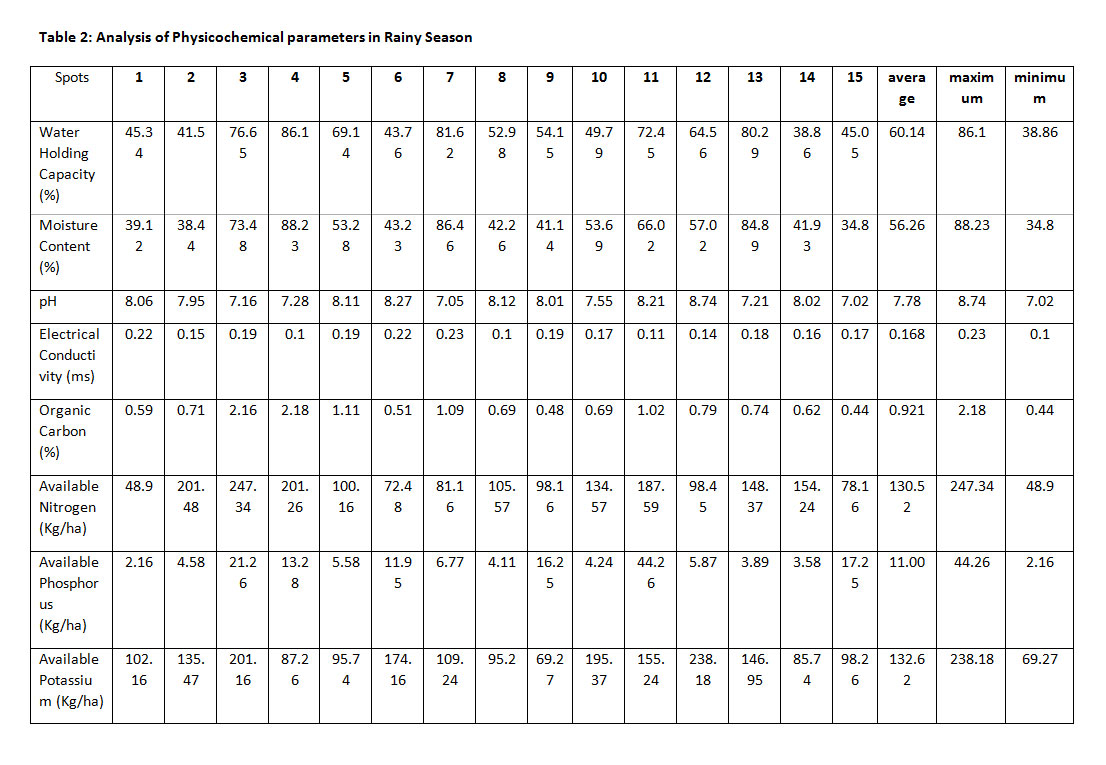 |
Table 2: Analysis of Physicochemical parameters in Rainy Season Click here to View Figure |
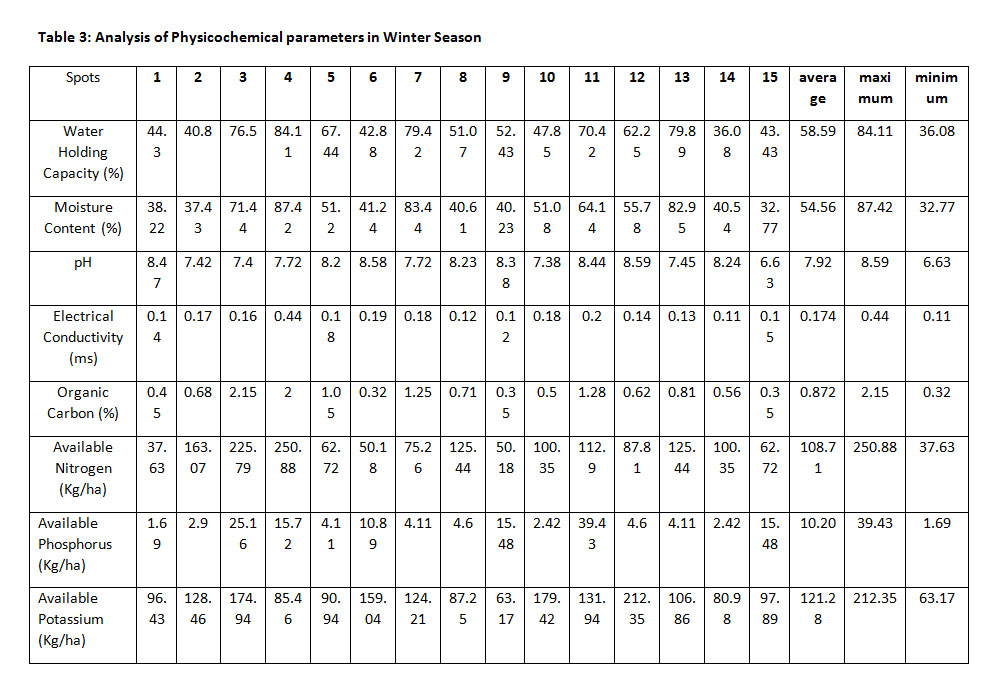 |
Table 3: Analysis of Physicochemical parameters in Winter Season Click here to View Figure |
 |
Table 4: Analysis of Physicochemical parameters in Summer Season Click here to View Figure |
Table 5: Shows the seasonal indices for each season and all soil parameters
|
Soil Parameters |
Seasonal Indices for Season |
||
|
Rainy season |
Winter season |
Summer season |
|
|
Sand % |
99% |
100% |
101% |
|
Slit % |
101% |
100% |
100% |
|
Clay % |
102% |
103% |
96% |
|
Water Holding Capacity (%) |
105% |
102% |
93% |
|
Moisture Content (%) |
104% |
101% |
94% |
|
pH |
99% |
101% |
100% |
|
Electrical Conductivity (ms) |
102% |
106% |
92% |
|
Organic Carbon (%) |
102% |
97% |
101% |
|
Available Nitrogen (Kg/ha) |
117% |
97% |
86% |
|
Available Phosphorus (Kg/ha) |
103% |
95% |
102% |
|
Available Potassium (Kg/ha) |
108% |
99% |
94% |
*Seasonal Index for ith season greater than 100 indicates average of ith season is greater than yearly seasonal average.
**Seasonal Index for ith season less than 100 indicates average of ith season is less than yearly seasonal average.
 |
Figure 6.1: Showing Visualization of Seasonal Indices. Click here to View Figure |
 |
Figure 6.2: Showing visualization of seasonal indices of soil texture. Click here to View Figure |
Conclusion
The Present study concludes that all soil physicochemical parameters found in normal criteria of healthy soil. It is also responsible for the excellent reach flora diversity of Gautala Reserve Forest and the studies of physical parameters interpret the nature and fertility of the soil. There were seasonal variations of the physical and chemical properties of soil, along with an angle of soil development. The investigation of physicochemical parameters of soil samples indicated different significances at different spots. It is due to the irregular status of various parameters present in the soil. Such kinds of observation of soil samples are beneficial to know the concentrations of different parameters present in soil samples. Besides these, the results from the Karl Pearson correlation method revealed that different seasons affect soil quality parameters. Overall, the present examination gives a baseline conclusion about the influence of specific forest types on soil physicochemical conditions.
Acknowledgments
The authors would like to thank to the forest department for granting the permission for the research work in the Gautala reserve forest and special thanks to wildlife staff of the Gautala sanctuary for the help during fieldwork.
Conflict of Interest
The authors do not have any conflict of interest.
References
- Ahmad I., Ahmad M. S. A., Hussian M., and Ashraf M. Y. Spatio-Temporal variations in soil characteristic and nutrient availability of an open scrub type rangeland in the sub–mountainous Himalayan tract of Pakistan. Pakistan Journal of Botany, 2011; 43(1):565-571.
- Ajgaonkar S.S. and Patil S. S. Soil health of soils in Aurangabad district (Maharashtra), India, An Asian Journal of Soil Science, ISSN–0976–7231, 2017; 12(1):121-127.
- Bhadra A K, Sahu B & Rout S P: A study of water quality index(WQI) of the river Brahmani, Odisha(India) to assess its potability: International Journal of Current Engg. & Technology, Vol-2014, 4(06).
- Black C. A., Evans D. D., Ensminger L. E., White J. L., Clark FE. Methods of soil analysis. Monogr 9. American Society of Agronomy, ASA, Madison, 1965.
- Bouslah S, Djemili L, Houichi L: Water quality index assessment of Koudiat Medouar Reservoir, northeast Algeria using weighted arithmetic index method. J Water Land Dev. 2017, 35:221–228.
- Chandra L. R., Gupta S., Pande V. And Singh N. Impact of forest vegetation on soil characteristics: a correlation between soil biological and physico-chemical properties, 3 Biotech,2016;6(2):188.
- Chaudhari Kiran G. Studies of the physicochemical parameters of soil samples, Advances in Applied Science Research, 2013; 4(6):246-248, ISSN: 0976-8610.
- Dar Zubair A., Qadri Humaira, Mir Shafat Ahmad, Beigh Bilal, Azra Amin. Assessment of Physico-Chemical Parameters of Forest Soil of Hirpora Wildlife Sanctuary, Kashmir. International Journal of Advance Research in science and engineering. 2018; 7(4):46-56, ISSN: 2319-8354. DOI: https://doi.org/10.15740/HAS/AJSS/12.1/121-127.
- Faruqi R. A., Bhat J. A., Farooq S., Haq S., and Khan O. A. Heavy Metal Deposition And Physico-Chemical Changes In Pine Forest Soil of Gulmarg As Influenced By Vehicular Pollution. International Journal of Recent Scientific Research, 2013; 6(4):891–894.
- Ganguli Sangita, Gupta Hema (Joshi), Bhattacharya Kashinath. Soil N-transformation Rates in Two Differently Managed Dry Deciduous Forests of West Bengal, India World Journal of Research and Review, 2016; 3(4):45-49. ISSN: 2455-3956.
- Geer and Guide. Ecological status of Narayan Sarovar Wildlife Sanctuary with a management perspective. Final Report, Gujarat Ecological Education and Research (GEER) Foundation, Gandhinagar and Gujarat Institute of Desert Ecology (GUIDE), Bhuj, India, 2001.
- Ghorade I. B. Eco sustainability assessment of Godavari river water for sustainable utilization. Guidance of Dr. Patil S.S. A thesis submitted to Dr. Babasaheb Ambedkar Marathwada University, Aurangabad, 2013.
- Grogan P., and Jonasson S. Controls on annual nitrogen cycling in the understorey of a sub-arctic birch forest. Ecology, 2003;84 (1):202–218.
- Hobbie S.E. Effects of plant species on nutrient cycling. Trends in Ecology and Evolution, 1992; 7(10):336-339.
- Horkar V. M., Totey N. G. Characterization of soils of Navegaon National Park (Maharashtra). Indian Journal of Forestry, 2002;25(2):127–135.
- Islam K. R., & Weil R. R.: Land use effects on soil quality in a tropical forest ecosystem of Bangladesh. Agriculture, Ecosystems and Environment, 2000; 79(1):9-16. DOI: https://doi.org/10.1016/0169-5347(92)90126-V
- Iwara A. I. Soil Erosion and Nutrient Loss Dynamics in Successional Fallow Communities in a part of the Rainforest Belt, South-Southern Nigeria. Ph.D. Proposal Presented at the Staff/Postgraduate Seminar, University of Ibadan, Nigeria; July. 2011. DOI: http://dx.doi.org/10.3923/rjasci.2011.276.281
- Jackson M. L. Soil chemical analysis,Verlag: Prentice Hall, Englewood Cliffs, 1958. DOI: https://doi.org/10.1002/jpln.19590850311
- Jeffery S., Gardi C., Jones A., Montanarella L., Marmo L., Miko L., (Eds.). European Atlas of Soil Biodiversity. European Commission, Publications Office of the European Union, Luxembourg.2010; 62(2):332-332. DOI: https://doi.org/10.2788/94222.
- Jina B. S., Bohra C. S., Lodhiyal L. S., and Sah P. Soil characteristics in oak and pine forests of Indian central Himalaya. International Scientific Research Journal, 2011;3 (1):2094-1749.
- Kshirsagar Anil A., Pawar Sanjay M., Patil Nirmala P., and Mali Vasant P.: Diversity of medicinal plants in Gautala Sanctuary of Kannad, District Aurangabad (Ms) India. Bioscience Discovery, 2012;3(3):355-361.
- Lamture S. V.: Soil chemistry of irrigated and non irrigated farmlands of Beed district, Maharashtra. Guidance of Dr. Patil S.S., A thesis submitted to Dr. Babasaheb Ambedkar Marathwada University, Aurangabad, 2015.
- Maria B. J., Garcia S., and Adrian E. Landscape and field-scale control of spatial variation of soil properties in Mediterranean montane meadows. Biogeochemistry, 2004;69(2):207-225.
- Mary L., Duryea R., Jeffery E., and Annie H. A comparison of landscape mulches; Chemical allelopathic; and decomposition properties. Journal of Arboriculture, 2006; 25(2):88-96.
- Mishra Ashish Kumar, Singh Kripal, Behera Soumit Kumar, Chaudhary Lal Babu, Singh Bajrang and Rahasya Mani Mishra.Soil Properties in Response to Different Plant Community Structures in Tropical Moist Deciduous Forest from Northern India. Climate Change and Environmental Sustainability, 2017;5(1):66-74.
- Mohd Salim, Kumar Pramod, Gupta M. K. and Kumar Saurabh, Seasonal Variation in some Chemical Characteristics of the Soil under different Land Uses of Jhilmil Jheel Wetland, Haridwar Uttrakhand, India. International Journal of Scientific and Research Publications, 2015; 5(10):1-9, ISSN 2250-3153.
- Moore T. R. Litter decomposition in a subarctic spruce-lichen woodland, eastern Canada. Ecology, 1981; 65(1):299-304.
- Naik V. N. Flora of Marathwada Vol. I & II Amrut Prakashan, Aurangabad, 1998.
- Olsen S, Watanabe F. S., Bowman R. A. Evaluation of fertilizer phosphate residues by plant uptake and extractable Phosphorus. Soil Sci Soc Am J, 1983; 47(5):952–958. https://doi.org/10.2136/sssaj1983.03615995004700050022x
- Pandey Naveen C. h., Tewari Lalit M., and Joshi G. C., Brij M. Upreti Physico-chemical characterization of Oak, Pine and Sal forest soil profiles of Betalghat Region of Kumaun Himalaya. Eurasian J Soil Sci, 2018; 7 (3):261-272.
- Pardeshi D S & Baidya S: Physico-chemical assessment of Waldhuni River Ulhasnagar, Thane, India- A case study: Int. J of Current Research & Academic Review, 2015, 3(4), 234-248.
- Pastor J., Naiman R. J., Dewey B. and Mclnnes P. Moose, microbes, and the boreal forest. Bioscience, 1988; 38 (11), 770-777. DOI: https://doi.org/10.2307/1310786
- Patil V.P., Vaghela B. N., Soni D. B., Patel P.N. and Jasrai Y. T. Carbon Sequestration Potential of the Soil of Jambughoda Wildlife Sanctuary, Gujarat, International Journal of Scientific and Research Publications, 2012;2(12):1-5.
- Penaâ€clarosMarielos, LourensPoorter, AlfredoAlarco, GeoffreyBlate, UrbanoChoque, Todd Fredericksen S., MarcoJustiniano J., ClaudioLean, Juan CarlosLicona, WilliamPariona, Francis E.Putz, LincolnQuevedo, and MarisolToledo. Soil Effects on Forest Structure and Diversity in a Moist and a Dry Tropical Forest. Biotropica, 2012; 44(3): 276–283. DOI: https://doi.org/10.1111/j.1744-7429.2011.00813.x
- Peverill K. I., Sparrow L. A., and Reuter D. J. Soil Analysis-an Interpretation Manual. CSIRO, Collingwood, Australia, 1999; 170-174,ISBN 0-643-06376-5.
- Ramamurthy V., Radhika K., Kavitha A. Amirthanayagi and Raveendran S. Physico-chemical analysis of soil and water of Vedaranyam mangrove forest, Tamil Nadu, India. International Journal of Advanced Life Sciences, 2012; 3(1):65-71, ISSN 2277–758XN.
- Saeed S., Barozai M. Y., Ahmad A., Shah S. H. Impact of altitude on soil physical and chemical properties in Sra Ghurgai (Takatu mountain range) Quetta, Balochistan. International Journal of Scientific & Engineering Research, 2014; 5(3):730-735.
- Semwal D. P., Uniyal P. L., Bahuguna Y. M. and Bhatt A. B. Soil nutrient storage under different forest types in a part of Central Himalaya, India. Ann. For., 2009; 17(1):43–52.
- Shirinfekr A., Fatemi C. A., Naghipoor B., and Keshavarz Z. The effect of types and quantities of organic fertilizers on the physical and chemical properties of soil and the performance of green tea. Proceedings of the Tenth Congress of Soil Studies,Karaj, Iran. Tehran University, 2007.
- Shourkaie S. G., Chaichi M. R., Saravi M. M., Hosseini H. M. S., and Lotfollahi M. Evaluation of grazing intensity effects on organic matter content and mineral nutrients recycling in rangeland soils (Case study: Mirza Bailue Rangelands, Golestoan Province, Iran). American-Eurasian Journal of Agric. Environ. Sci.,2007;2(5):504-510.
- Siddiqui Shahid Ali and Naseem Fatima. Indian Soils- Identification and Classification, Earth Science India, 2017;10 (III):1-14.
- Sivansan K., Mithyantha M. S., Natesan S., and Subharayappa C. T. Physiochemical properties and nutrient management of red and literate soils under plantation crops in southern India. NBSS publication, 1993;37:280.
- Stanford G., Smith S. J. Oxidative release of potentially mineralizable soil nitrogen by acid permanganate extraction. Soil Sci, 1978; 126:210–218.
- Takata Y., Funakawa S., Akshalov K., Ishida N., and Kosaki T Regional evaluation of the spatiotemporal variation in soil organic carbon dynamics for rain fed cereal farming in northern Kazakhstan. Soil Science Plant Nutrition, 2008;54(5):794-806.
- Tewari Geeta, Khati Deepti, Rana Lata, Yadav Poonam, Pande Chitra, Bhatt Sunita, Kumar Vinod, Joshi Neeta and Joshi Prasoon K. Assessment of Physicochemical Properties of Soils from Different Land Use Systems in Uttarakhand, India J. Chem. Eng. Chem. Res., 2016; 3(11):1114-1118.
- Walkley A., Black I. A. an examination of the Degtjareff method for determining soil organic matter and a proposed modification of chromic acid titration method. Soil Sci, 1934; 37(1):29–38.






